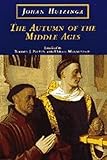The autumn of the Middle Ages / Johan Huizinga ; translated by Rodney J. Payton and Ulrich Mammitzsch.
Material type: TextLanguage: English Original language: Dutch Publication details: Chicago : University of Chicago Press, 1996.Description: xxii, 467 p. : ill. ; 24 cmISBN:
TextLanguage: English Original language: Dutch Publication details: Chicago : University of Chicago Press, 1996.Description: xxii, 467 p. : ill. ; 24 cmISBN: - 0226359921
- 9780226359922
- 0226359948 (pbk.)
- 9780226359946 (pbk.)
- Herfsttij der Middeleeuwen. English
- ARCH YNDC 944.025 P347A
- DC33.2 .H83 1996
- Also issued online.
| Item type | Current library | Collection | Call number | Status | Date due | Barcode | |
|---|---|---|---|---|---|---|---|
 Archives
Archives
|
SAIACS Archives Room | Yandell Collection | ARCH YNDC 944.025 P347A (Browse shelf(Opens below)) | Not for loan | 063649 |
Includes bibliographical references (p. 441-449) and index.
The passionate intensity of life -- The craving for a more beautiful life -- The heroic dream -- The forms of love -- The vision of death -- The depiction of the sacred -- The pious personality -- Religious excitation and religious fantasy -- The decline of symbolism -- The failure of imagination -- The forms of thought in practice -- Art in life -- Image and word -- The coming of the new form.
So begins one of the most famous works of history ever published, Johan Huizinga's The Autumn of the Middle Ages. Few who have read this book in English realize that The Waning of the Middle Ages, the only previous translation, is vastly different from the original Dutch, and incompatible with all other European-language translations. Now, for the first time ever, the original version of this classic work has been translated into English. Herfsttij der Middeleeuwen, or The Autumn of the Middle Ages - the original title - is a brilliant portrait of life, thought, and art in fourteenth- and fifteenth- century France and the Netherlands. For Huizinga, this period marked not the birth of a dramatically new era in history, the Renaissance, but the fullest, ripest phase of medieval life and thought. Criticized both at home and in Europe for being "old-fashioned" and "too literary" when first published in 1919, the book is now recognized not only for its quality and richness as history, but also as a precursor to the Annales "histoire des mentalites" school of Marc Bloch and Lucien Febvre, two of the few reviewers who praised the book initially. In the 1924 translation, Fritz Hopman adapted, reduced, and altered the Dutch edition - softening Huizinga's often passionate arguments, dulling his nuances, and eliminating theoretical passages. He dropped many passages Huizinga had quoted in their original old French. Additionally, chapters are rearranged and redivided, all references are dropped, and mistranslations are introduced. This translation corrects such errors, recreating the second Dutch edition - which represents Huizinga's thinking at its most important stage - as closely as possible. Everything that was dropped or rearranged has been restored. Prose quotations appear in French, with translations printed at the bottom of the page. Mistranslations have been corrected. Payton and Mammitzsch also have added helpful material, including Huizinga's preface to the first and second Dutch editions (published in 1919 and 1921) and the one to the 1924 German translation, where he touches on the book's title and offers some thoughts on translations. Several notes clarify Huizinga's references to things which would be common knowledge only to Dutch readers. Huizinga frequently refers to paintings, sculptures, and carvings, some little known; this edition is the first in any language to include a full range of illustrations.
Also issued online.
'This translation is based on the 1921 edition of Herfsttij der Middeleeuwen' -- tp. verso.
There are no comments on this title.

